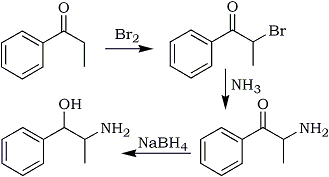
Caution:
The operation must be carried out outside or under a fume hood. Safety goggles and protecting glasses are a must. Do not get in contact with the intermediate, alpha-bromo- propiophenone, which is a lachrymator and very irritating to the eyes, throat and bare skin.
alpha-Bromopropiophenone
In a 2000 two-necked round-bottomed flask with dropping funnel and reflux condenser, dissolve 1 mole (134.2g) propiophenone in 250 mL glacial acetic acid. Cool the mixture in an ice-bath, and add over a period of an hour 1.05 moles of bromine (168 g; 53.5 mL) in 150 mL glacial acetic acid with stirring, the temperature in the mixture should be at 10-20°C. After the hour, heat on the water bath with stirring, bath temperature 50°C for 4 hrs, and evaporate the volatiles by vacuum distillation. The residue is an oil, alpha-bromopropiophenone, which is used directly without purification. The product is kept in this flask.
Cathinone
Saturate 800 mL alcohol (95 %) with ammonia (generated from sodium hydroxide and ammonia solution), 100 g should be in the solution (so saturate the alcohol until its weight is 100 g higher). Add the alcoholic ammonia to the flask with the alpha-bromopropiophenone, carefully, with stirring, using a reflux condenser and a dropping funnel. Stirr for 2 hrs at 20°C and then for 6 hrs. at 60°C to get 2-amino-1-phenyl-1-propanone. The solution is concentrated to dryness at the rotary evaporator, and water/ammonia solution (1:1, 500 mL) is added. Add 50g NaCl (table salt) to reduce the solubility of the product, extract the product four times with 400 mL methyl tert-butyl ether, and evaporate the extract (no drying) at the rotary evaporator.
Phenylpropanolamine (PPA)
Dissolve the residue in 500 mL THF/2-propanol (1:1 by volume), (two-necked round bottom flask 2000 mL, condenser, one neck with stopper), and add 40g finely powdered sodium borohydride (NaBH4), in small portions (2-3g each - Note: Frothing). Stir for 24 hrs, and add dilute acetic acid until the gas (BH3 - H2) evolution subsides [Caution: Do not inhale! Borane is very poisonous]. Add then hydrochloric acid to pH 1, evaporate all volatiles in vacuum to dryness at the rotary evaporator, and add 50% sodium hydroxide (200 mL), table salt (100 g). Extract your product with 4x400 mL methyl tert-butyl ether, dry over sodium sulfate, and evaporate the solvent at the rotary evaporator. The residue is about about 100g of fairly pure (±)-1-Phenyl-2-Amino-1-Propanol [dl-PPA], which crystallizes on standing, mp 52-53°C. If the melting point is off (and hence the purity) the product may be vacuum distilled.
For reduction to dl-amphetamine, vacuum distillation is not is not necessary until you use hydrogen and catalyst.